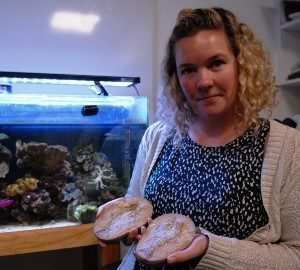
An international team of scientists from Flinders University and Sweden are ‘doing the brain warp’ in a bid to understand the evolution of a very ‘brainy’ fish species.
They are reconstructing ancient fish brains via innovative X-ray scanning technology, 3D computer modelling and custom software to trace the links between 385 million-year-old fossils and one of their closest living relations, the Australian lungfish (Neoceratodus).
“We can use the ‘brain warp’ computer technique to virtually morph the ‘modern’ brain of the lungfish into the early cranial cavity, or fossil endocast, from the fossil Rhinodipterus found in a renowned Devonian site in Western Australia,” says Flinders University Research Associate Dr Alice Clement.
“This is an exciting way to more accurately reconstruct and understand changes in the brain and behaviour over the centuries.
“In fish, it can help us understand in which groups and when certain senses such as smell or vision became more important than others, and how the development of higher cognitive centres may have helped some groups flourish while others flounder.”
The research, which found some moderate evolutionary changes in the brain compared to the prehistoric lungfish, has been published in The Royal Society Open Science journal.
Unlike most fish, lungfish have relatively large brains, filling more than 80% of the cranial cavity. They have long fascinated researchers due to their close relationship with land-dwelling animals with a backbone, tetrapods – the group that includes humans.
In this way, lungfish – which have both gills and lungs – can be thought of as “our fishy cousins”, says Dr Clement, and provide “great insight into our ancient ancestors who first crawled out of water and onto land some 370 million years ago”.
The technique could also be used to explore the evolution of many other animals, says Strategic Professor John Long, from Flinders’ Palaeonotology Group in the School of Biological Sciences at Flinders.
“We believe our new brain-warp technique can be adopted across many other fossil groups and will revolutionise the way scientists restore fossil brains and how they study them,” Professor Long says.
“In particular, brains are the powerhouses that control everything from heartbeat and breathing, to learning and emotional intelligence.
“Animals’ soft tissue usually breaks down, so discovery of a fossilised brain is very rare.
“This technique will allow us to use computer modelling to fill in the gaps within hard skeletal remains.”
Professor Per Ahlberg, from Sweden’s Uppsala University, says the new technology will allow more accurate reconstruction of early vertebrates’ brains.
“The approach we present here makes the process much more rigorous, by taking the known relationship in a living form and ‘retro-fitting’ it to the cranial cavity of the fossil,” Professor Ahlberg says.
‘Using the brain-neurocranial relationship in the extant Australian lungfish to interpret fossil endocasts’ involved research by Dr Clement and Professor Long at Flinders and Professor Ahlberg, Associate Professor Robin Strand and Johan Nysjö at Uppsala University.
Much of the research was carried out in 2013-15 when Dr Clement worked in Sweden with Professor Ahlberg, with funding from the Knut and Alice Wallenberg Fund.
The Australian lungfish, or Neoceratodus forsteri, is the sole remaining member of its family alive today, and has a history extending back to the time of the dinosaurs. Fossils of the Australian lungfish were described years before the living animal became known to modern science (although Indigenous Australians had known of its existence for thousands of years).
Lungfish tooth plates of Cretaceous age (more than 65 million years old) have been discovered in New South Wales, and are indistinguishable from those of living lungfish. It is for this reason Neoceratodus is often described as a ‘living fossil’ as it is the most enduring vertebrate species on Earth.

